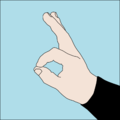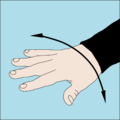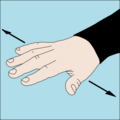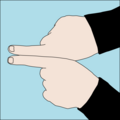Diving sign
Diving signs are gestures or other, mostly non-verbal signs for communication between divers underwater. The knowledge of basic diving signs is part of every diving training , for example to be able to make your diving partner aware of dangers. Dive signs can be questions, answers, or instructions. As a rule, the partner expects a reaction or confirmation at his sign. 31 diving symbols are internationally standardized. However, there are a total of over 160 different diving signals , which can even vary slightly, which is why the hand signals to be used are often agreed in the briefing before the dive.
Hand signals
Although sound can move well in water, communication under water using the human voice is only possible to a limited extent without electronic communication systems. Electronic systems or systems based on ultrasound , however, require complex and expensive diving equipment such as a full face mask or diving helmet . Most divers, especially recreational divers , do not use such equipment and therefore their communication depends on diving signs.
In order to be able to communicate with diving signs, the diving buddies mostly have to look at each other. An exception is diving in the dark, in which both diving partners can communicate via lamp movements while both keep an eye on the bottom. The most important diving signs can be given with one hand so that they can also be given in the dark. The diving torch is guided with one hand in order to illuminate the other hand.
Speaking is the obvious way to communicate on the surface of the water. However, to speak, the regulator or snorkel must be removed from the mouth. At greater distances, for example when communicating between the diving group and supporters on a ship, verbal communication can be made more difficult by wind or engine noise. The diving signs common underwater are difficult to see even at medium distances, especially when there are waves. This is remedied by special surface signals that are clearly recognizable even from a distance.
Standardized diving signs
In December 2005, the WRSTC , which brings together many important diving organizations , standardized 31 hand signals that every diver should master after completing basic diving training . These 31 diving symbols were later part of the international standard ISO 24801-2 and thus also adopted by most of the diving organizations that do not belong to the WRSTC in their basic diving training :
- I'm short of air : wave a fist against my chest several times. (a warning sign)
- Come here! : Swing the hand pointing upwards towards the chest several times with fingers folded together.
- Under , over or all around : move the flat hand, thumb under the palm, away from you to indicate the intended direction of the dive.
Waving with one or both hands or arms means: I need help! or an emergency! Therefore, divers should never wave a greeting. Nor does it make sense to wave to a diver from land or from a boat. It is better to use the surface symbol for I am OK as a greeting . .
Not standardized diving signs
The following diving symbols are not standardized and can therefore vary depending on the diving organization, language and world region. In addition, a large number of non-standardized characters are used, which stand for certain underwater creatures.
Diving
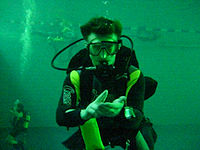 |
Check your breathing gas supply |
 |
Repeat |
 |
question |
numbers
The answer to the question about the air still available is as follows:
 |
10 bar or 100 psi |
 |
20 bar or 200 psi |
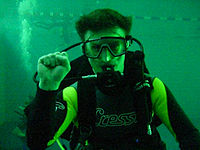 |
50 bar or 500 psi (beginning of reserve) |
 |
100 bar or 1500 psi |
 |
200 bar or 3000 psi |
Numbers 1 to 9 are not uniform for diving organizations. However, this is not a problem, as the digits in context are mostly self-explanatory. These signs can vary depending on the region and diving organization, which is why you should discuss it with your buddy before diving.
Creature
Signs are used for a large number of different underwater creatures, but these are not standardized. It is therefore advisable to ask local divers before the dive about the most common symbols - and thus also about the most common animals worth seeing - and to coordinate these with your diving partner.
Light sign
When diving at night , the hand signals can be recognized poorly or not at all. Diving signals are then given by means of a diving lamp . The sign is usually drawn on the bottom directly in front of the buddy. In order not to dazzle the diving partner, it is not shined directly in the eyes. His attention can be attracted by lighting his hand. Many divers already interpret hectic lamp movements as warning signs.
Linen sign
If visibility is poor, both diving partners can be connected with a line; in ice diving , the line is usually brought to the surface. The signals are then transmitted by pulling the rope.
- One move: OK / OK?
- Two trains: stop
- Three moves: submerge
- Four moves: emerge
- Continuous pulling: emergency! Emerge to the surface! or bring me to the surface!
See also: Line signs for rescue diving
Further communication options
Other possible means of communication under water include:
Writing board
In order to communicate more complex facts, corresponding messages can be written on writing boards or special notepads (wetnotes) and shown to the diving partner. However, this type of communication is time-consuming and requires the concentration of the writer, which carries potential risks. Therefore, if possible, fixed diving signs are used, which are supplemented by individual gestures if necessary.
Sign language, finger alphabet
Sign language can often only be used with restrictions, as the associated facial expressions are only possible to a very limited extent with diving equipment. The finger alphabet is more suitable , in particular the international one-handed finger alphabet.
Human voice
Communication by means of the human voice is only possible to a very limited extent under water and should be regarded as an unreliable means of communication.
Other noises
It is also possible to make sounds that divers can hear underwater. These include compressed air fanfares, e.g. B. can be operated with the breathing gas, or metallic rattles (shakers) . Such signal transmitters can also be improvised, for example by hitting the diving cylinder with a metallic object (e.g. carabiner). Simple devices called tank bangers are also available, with which a typical, easily audible noise can be generated underwater. A previously tensioned elastic pulls a plastic ball against the diving bottle when it is released and generates a noise. These sound signals do not have a fixed meaning, but are mostly used to attract attention. It should be noted, however, that noises cannot be localized under water.
literature
- Dave van Stijn, Mike Harterink: Scubasigns - The guide to all diving signals. B for Books Bv / Stichting Scubasigns (Scubasigns Foundation, Netherlands) 2009, ISBN 978-90-90-24165-4 . (English)
- Diving sign - communication underwater. Over 160 hand signals for divers and those who want to become one. ok2dive, 2012, ISBN 978-3-9813148-0-9 .
Web links
- Private collection of various underwater signs (as photos and graphics)
- International diving marks. ( Memento from February 17, 2013 in the web archive archive.today ) List of important international diving symbols as graphics
- Underwater signs as photos, some with movements on Novota divers
- Sign language of divers and expected reactions
- Additional hand signals when diving in caves
Individual evidence
- ↑ a b c d e f g h Sonja Hönig: diving sign - communication under water. 1st edition. ok2dive UG, Groß-Zimmer, ISBN 978-3-9813148-0-9 .
- ↑ Common hand signals for recreational scuba diving. (PDF; 5.9 MB) World Recreational Scuba Training Council , Jacksonville, December 1, 2005, accessed on April 4, 2013 .
- ↑ Recreational diving services - Requirements for the training of recreational scuba divers - Part 2: Level 2 - Autonomous diver (ISO 24801-2). ISO , accessed April 29, 2015 .
- ↑ Diver Underwater Hand Signals. Scuba.com, INC., Accessed January 1, 2017 .




